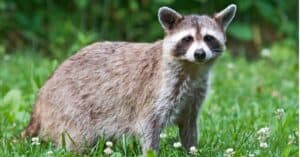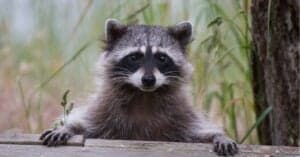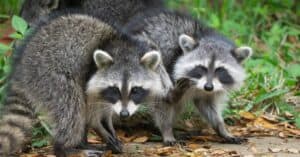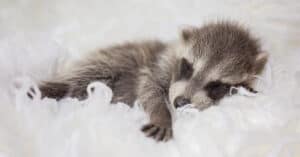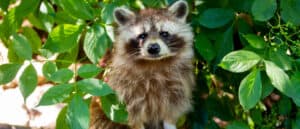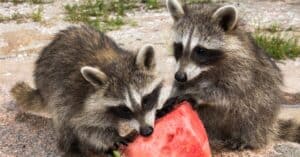What Do Raccoons Eat?
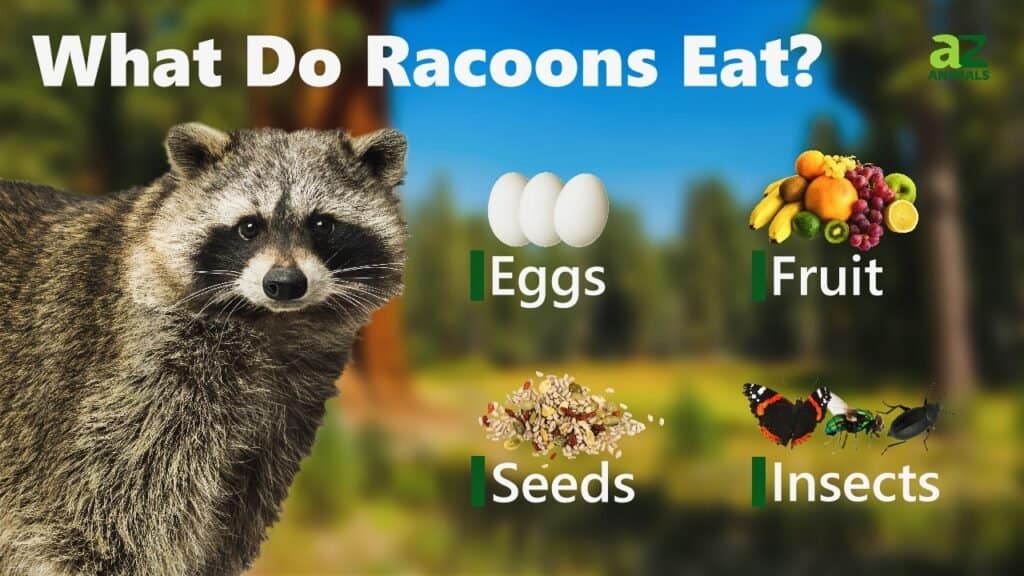
A-Z-Animals.com
Opportunism, at least in the ecological sense, is defined as the practice of acquiring food by practically any means necessary. Raccoons aren’t constrained by a single food source; instead, they have a choice in which food they want to eat at a given time. It’s estimated that their diet is composed of a fairly even split between plant matter, invertebrates, and vertebrates. Plant matter is fairly easy to acquire outside of winter and, in some locations, their main source of food. They are more likely to favor invertebrates over vertebrates by a small margin, simply because of how common they are and how easy they are to catch. But ultimately, it just depends on what happens to be available at the time.
As generalized opportunists, raccoons are not natural or capable hunters; they don’t dedicate a lot of time to tracking and killing prey. But when they do spy an easy opportunity to hunt, their usual prey includes live frogs, snakes, crayfish, snails, and small rodents like mice and squirrels. Hunting, after all, is a massive waste of energy when there are far easier food items they can forage; dead carrion, insects, and worms are among the most common types of meat in their culinary repertoire. They will even attempt to steal eggs or small hatchlings from bird nests if they sense an opportunity to get away with it.
Depending on how much food is available in their area, these voracious omnivores can travel more than a mile per night in search of something to eat. Females are almost always either pregnant or accompanied by the young, which means they have multiple mouths to feed, while males forage alone. These omnivores will tend to visit similar foraging grounds every night to avoid wasting time and therefore energy. Some evidence suggests that individual raccoons can develop preferences for certain foods.
The raccoon’s diet tends to vary quite a bit with the changing of the seasons. In the summer, they feed upon the greatest variety of foods, including meat, fruits, nuts, acorns, walnuts, and sometimes even corn. Some of their favorite fruits include apples, grapes, cherries, peaches, plums, and berries (it may even help to disperse plant seeds throughout the environment). By the late autumn, raccoons will need to have built up a sufficient amount of fat for the lean winter months, at least in the northern part of their range, where feeding becomes much more difficult. That is why you will often see raccoons grow fatter during the autumn months and then lose a lot of weight, potentially as much as half of it, by the spring. They do not hibernate for the winter; their metabolic rate remains fairly constant. However, they do dramatically lower their activity level to prevent any unnecessary energy expenditure.
Location is also a huge factor in the composition of their diet, especially the types of plants they consume. A raccoon in Mexico will tend to have a different diet from a raccoon in Washington or Virginia, as well as Japan. Southern raccoons will have more food options in the winter and therefore tend to be more active all year-round.
What Do Raccoons Eat in the Wild?
Raccoons live in almost every state of the United States, and they normally inhabit woodlands and forests. A raccoon prefers to live in a tree cavity close to a river, pond, or other body of water. If no tree cavity is available, the raccoon will move into any hollowed-out spot. At night, they hunt along the water’s edge.
Raccoons like seafood. They fish for clams, crawfish, frogs, snails, snakes, and fish. Raccoons prefer animals that live in shallow water, so they will also eat turtles and snakes if they’re easy to catch. They eat a balanced diet, however, as they also eat many fruits, wild herbs, seeds, nuts, and slugs. Their favorite fruits include cherries, apples, and whatever else grows near their den. They are not expert hunters, but they will try to catch birds or small rodents if other food is scarce. They will also eat birds’ eggs, grubs, and insects.
If they live near farms, raccoons may raid chicken coops to steal eggs or baby chicks.
Raccoons in the wild eat most heavily during the spring, summer, and fall. They do this to make sure there is enough fat on their bodies to get through the winter when food is scarce or the weather keeps them indoors.
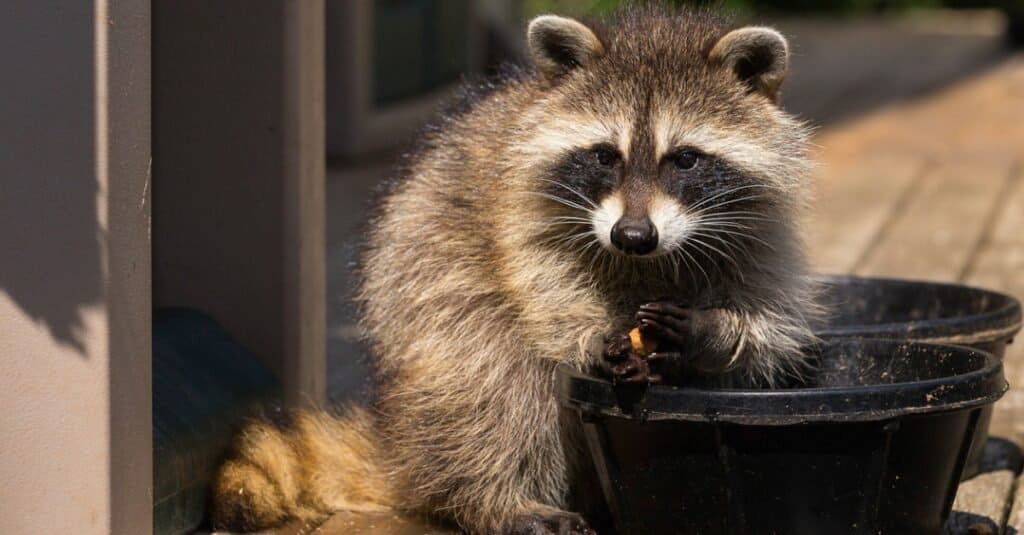
AEWD/Shutterstock.com
Why Do They Wash Their Food?
The raccoon has a very well-known behavior in which it douses food in water or rubs off unwanted parts with its hands before consuming it. This behavior is even reflected in the raccoon’s scientific name: lotor is Latin for washer. However, despite appearances, the raccoon may not be washing its food after all. Instead, this behavior might be related to the raccoon’s very sensitive sense of touch. The hairless parts of their forepaws contain lots of nerve endings that convey important information about the size, texture, and temperature of what they’re holding. A few studies have suggested that dousing food may help increase the tactile sensitivity of their paws. However, these studies were done on captive raccoons, and it’s not entirely clear how much this behavior occurs in the wild.
How Neighborhood Raccoons Eat
Raccoons in suburban areas eat birdseed, pet food, and water from fountains or pet bowls. Those who feed on trash cans gravitate to leftover pet food, meat, junk food, fruits, and vegetables. They will eat any food that isn’t rotted or mildewed.
One of the most interesting things about raccoons is how well they have adapted to life in human environments. Raccoons are everywhere, and their willingness to eat anything means they are happy to feast on leftovers from our trash cans. This adaptability is so interesting that the New York State Department of Environmental Conservation once commissioned a study to find out how they do it. The 1986 research study examined the ways raccoons manage to find food and avoid being hunted or trapped in their suburban hangouts. In fact, raccoons in the wild typically weigh about 30 pounds, but the average suburban raccoon can weigh up to 60 pounds.
A 2016 documentary by National Geographic reported that 50 times more raccoons were living in Toronto than in the surrounding countryside. Researchers have noted that other animal populations, including white-tail deer, squirrels, Canada geese, and seagulls, all seem to thrive despite the increasing encroachment on their habitats. There may be good reasons for this. Cities and suburban areas don’t have the large predators that live in forests and eat raccoons. People don’t hunt deer or raccoons in the suburbs.
Sometimes, their ability to survive has created problems. Raccoons have been introduced to several countries where they are not native, including Japan. Japan began importing raccoons in the 1970s. They quickly became invasive pests that damaged buildings and native species. Raccoons imported to Germany overran the countryside there. The only solution was to destroy raccoon populations in both countries.
It’s another warning that importing species is rarely a good idea. Non-native animals and plants often become invasive and destroy native ecosystems.
Like all animals, raccoons are better left in their natural environments, even if those environments are suburban lawns and streets.
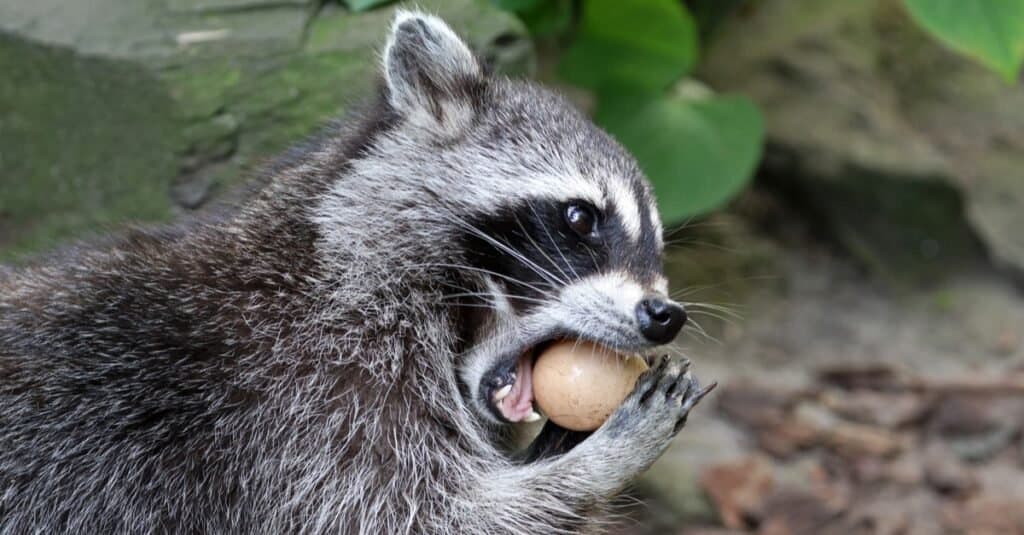
Edwin Butter/Shutterstock.com
Do They Really Like Garbage or Dirty Food?
The idea that raccoons like dirty food is popular, but isn’t true. They simply eat food that we consider trash but is still perfectly good. In their view, we are wasting perfectly good food like a few bites of meat on a bone or some fruit that’s starting to soften. They are discerning about their food, which is why they use water to help them get information about it.
In the wild and the suburbs, raccoons are lazy. They are not hunters and are not willing to spend hours fishing in deep water. They like food that’s nearby and easy to catch. Eating our leftovers is a quick, easy way to get a few bites without much effort.
What Do Raccoons in Captivity Eat?
In a zoo or wildlife refuge, a raccoon will eat a diet that reflects its natural one. It will include slugs, worms, fruits, berries, seeds, fish, and eggs. They may be fed chicken or specially processed raccoon food. They will also have one bowl of water for drinking and another for dunking their food.
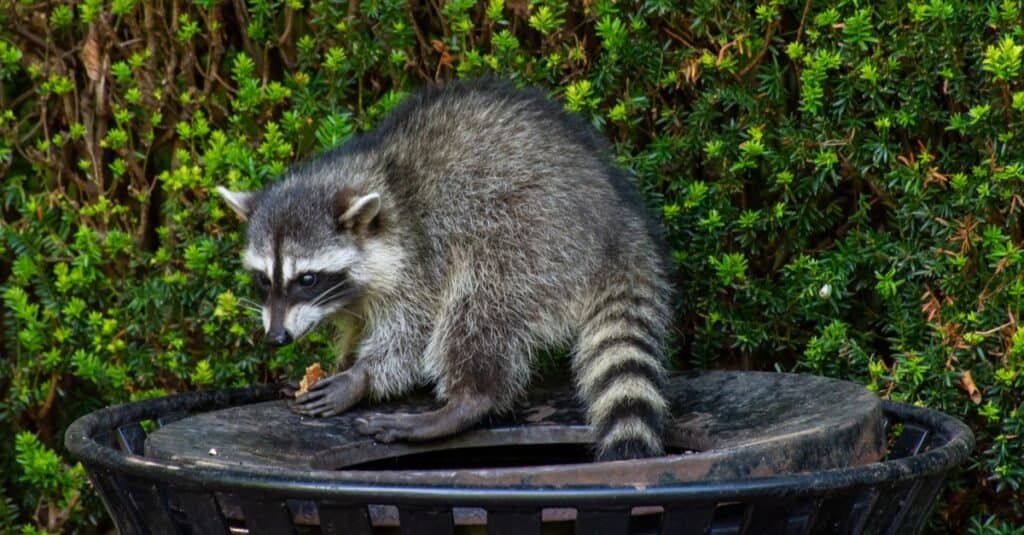
kingma photos/Shutterstock.com
A Complete List of the Top 10 Foods the Raccoon Eats
Raccoons eat so many different foods that it’s difficult to list them all individually. Here they are grouped up into larger categories of foods.
- Insects
- Fruits
- Nuts
- Eggs
- Worms
- Snakes
- Rodents
- Snails
- Frogs
- Crayfish
Are There Any Foods They Can’t Eat?
Although they are omnivorous, there are some things raccoons can’t eat:
- Chocolate, onions, raisins and macadamia nuts are toxic to raccoons.
- Garlic and bread aren’t toxic, but they can upset a raccoon’s digestion.
- Coffee, cocoa and candies can cause health problems in raccoons.

Who Eats Raccoons?
Larger predators like coyotes, bobcats, and cougars all prey on raccoons in the wild. Some humans have also eaten raccoons. That’s how a raccoon came to live at the White House.
In 1926, President Calvin Coolidge received a live raccoon as a gift. The raccoon was intended as part of the president’s Thanksgiving dinner, but Coolidge refused to kill her. Instead, he and his family adopted her as a pet raccoon and named her Rebecca.
Rebecca became a favorite with the family, especially with First Lady Grace Coolidge. They built a treehouse for her and gave her free rein of the White House grounds. When the Coolidges left the White House, Rebecca went to live at Rock Creek Zoo, which is now the Washington Zoo.
Nature’s Food Finders
Raccoons may be nature’s best food finders. Their willingness to eat almost anything and their ability to find good food in a pile of trash have helped them adapt and survive where other animals would have difficulty. Whether they’re in the wild forests or your backyard, a raccoon is certain to find a good meal.
Next Up: Golden Eagle vs Bald Eagle: 8 Key Differences Explained
FAQs (Frequently Asked Questions)
Are raccoons carnivores, herbivores or omnivores?
They are omnivores. Raccoons will eat almost anything, but it’s not true that they eat actual garbage or rotting food.
Do raccoons carry rabies?
Not all raccoons carry rabies. Because they are nocturnal, many people mistakenly think that any raccoon you see in the daytime is rabid. This isn’t true. If you see a raccoon in the daytime, it may be hungry or looking for a new den.
Your chance of catching rabies is low. According to the Centers for Disease Control, there are only 1 to 3 reported cases of human rabies in the U.S. every year.
Are raccoons dangerous to humans?
Raccoons have learned to live among humans without causing much damage beyond tipped-over garbage cans and infesting attics. They are not domestic pets, however, and raccoons can fight fiercely if they are attacked or threatened. They have sharp claws and teeth, and they can inflict major damage on animals and humans.
Raccoons are also carriers of several diseases they can transmit to humans. Along with foxes, skunks, and bats, they are one of four species that can carry rabies. Raccoons are also carriers of giardiasis and a roundworm parasite that lives in their feces.
If you must handle raccoons, use protective clothing and gloves. Wash your hands and clothes thoroughly after handling them.
More from A-Z Animals

A-Z-Animals.com
Opportunism, at least in the ecological sense, is defined as the practice of acquiring food by practically any means necessary. Raccoons aren’t constrained by a single food source; instead, they have a choice in which food they want to eat at a given time. It’s estimated that their diet is composed of a fairly even split between plant matter, invertebrates, and vertebrates. Plant matter is fairly easy to acquire outside of winter and, in some locations, their main source of food. They are more likely to favor invertebrates over vertebrates by a small margin, simply because of how common they are and how easy they are to catch. But ultimately, it just depends on what happens to be available at the time.
As generalized opportunists, raccoons are not natural or capable hunters; they don’t dedicate a lot of time to tracking and killing prey. But when they do spy an easy opportunity to hunt, their usual prey includes live frogs, snakes, crayfish, snails, and small rodents like mice and squirrels. Hunting, after all, is a massive waste of energy when there are far easier food items they can forage; dead carrion, insects, and worms are among the most common types of meat in their culinary repertoire. They will even attempt to steal eggs or small hatchlings from bird nests if they sense an opportunity to get away with it.
Depending on how much food is available in their area, these voracious omnivores can travel more than a mile per night in search of something to eat. Females are almost always either pregnant or accompanied by the young, which means they have multiple mouths to feed, while males forage alone. These omnivores will tend to visit similar foraging grounds every night to avoid wasting time and therefore energy. Some evidence suggests that individual raccoons can develop preferences for certain foods.
The raccoon’s diet tends to vary quite a bit with the changing of the seasons. In the summer, they feed upon the greatest variety of foods, including meat, fruits, nuts, acorns, walnuts, and sometimes even corn. Some of their favorite fruits include apples, grapes, cherries, peaches, plums, and berries (it may even help to disperse plant seeds throughout the environment). By the late autumn, raccoons will need to have built up a sufficient amount of fat for the lean winter months, at least in the northern part of their range, where feeding becomes much more difficult. That is why you will often see raccoons grow fatter during the autumn months and then lose a lot of weight, potentially as much as half of it, by the spring. They do not hibernate for the winter; their metabolic rate remains fairly constant. However, they do dramatically lower their activity level to prevent any unnecessary energy expenditure.
Location is also a huge factor in the composition of their diet, especially the types of plants they consume. A raccoon in Mexico will tend to have a different diet from a raccoon in Washington or Virginia, as well as Japan. Southern raccoons will have more food options in the winter and therefore tend to be more active all year-round.
What Do Raccoons Eat in the Wild?
Raccoons live in almost every state of the United States, and they normally inhabit woodlands and forests. A raccoon prefers to live in a tree cavity close to a river, pond, or other body of water. If no tree cavity is available, the raccoon will move into any hollowed-out spot. At night, they hunt along the water’s edge.
Raccoons like seafood. They fish for clams, crawfish, frogs, snails, snakes, and fish. Raccoons prefer animals that live in shallow water, so they will also eat turtles and snakes if they’re easy to catch. They eat a balanced diet, however, as they also eat many fruits, wild herbs, seeds, nuts, and slugs. Their favorite fruits include cherries, apples, and whatever else grows near their den. They are not expert hunters, but they will try to catch birds or small rodents if other food is scarce. They will also eat birds’ eggs, grubs, and insects.
If they live near farms, raccoons may raid chicken coops to steal eggs or baby chicks.
Raccoons in the wild eat most heavily during the spring, summer, and fall. They do this to make sure there is enough fat on their bodies to get through the winter when food is scarce or the weather keeps them indoors.

AEWD/Shutterstock.com
Why Do They Wash Their Food?
The raccoon has a very well-known behavior in which it douses food in water or rubs off unwanted parts with its hands before consuming it. This behavior is even reflected in the raccoon’s scientific name: lotor is Latin for washer. However, despite appearances, the raccoon may not be washing its food after all. Instead, this behavior might be related to the raccoon’s very sensitive sense of touch. The hairless parts of their forepaws contain lots of nerve endings that convey important information about the size, texture, and temperature of what they’re holding. A few studies have suggested that dousing food may help increase the tactile sensitivity of their paws. However, these studies were done on captive raccoons, and it’s not entirely clear how much this behavior occurs in the wild.
How Neighborhood Raccoons Eat
Raccoons in suburban areas eat birdseed, pet food, and water from fountains or pet bowls. Those who feed on trash cans gravitate to leftover pet food, meat, junk food, fruits, and vegetables. They will eat any food that isn’t rotted or mildewed.
One of the most interesting things about raccoons is how well they have adapted to life in human environments. Raccoons are everywhere, and their willingness to eat anything means they are happy to feast on leftovers from our trash cans. This adaptability is so interesting that the New York State Department of Environmental Conservation once commissioned a study to find out how they do it. The 1986 research study examined the ways raccoons manage to find food and avoid being hunted or trapped in their suburban hangouts. In fact, raccoons in the wild typically weigh about 30 pounds, but the average suburban raccoon can weigh up to 60 pounds.
A 2016 documentary by National Geographic reported that 50 times more raccoons were living in Toronto than in the surrounding countryside. Researchers have noted that other animal populations, including white-tail deer, squirrels, Canada geese, and seagulls, all seem to thrive despite the increasing encroachment on their habitats. There may be good reasons for this. Cities and suburban areas don’t have the large predators that live in forests and eat raccoons. People don’t hunt deer or raccoons in the suburbs.
Sometimes, their ability to survive has created problems. Raccoons have been introduced to several countries where they are not native, including Japan. Japan began importing raccoons in the 1970s. They quickly became invasive pests that damaged buildings and native species. Raccoons imported to Germany overran the countryside there. The only solution was to destroy raccoon populations in both countries.
It’s another warning that importing species is rarely a good idea. Non-native animals and plants often become invasive and destroy native ecosystems.
Like all animals, raccoons are better left in their natural environments, even if those environments are suburban lawns and streets.

Edwin Butter/Shutterstock.com
Do They Really Like Garbage or Dirty Food?
The idea that raccoons like dirty food is popular, but isn’t true. They simply eat food that we consider trash but is still perfectly good. In their view, we are wasting perfectly good food like a few bites of meat on a bone or some fruit that’s starting to soften. They are discerning about their food, which is why they use water to help them get information about it.
In the wild and the suburbs, raccoons are lazy. They are not hunters and are not willing to spend hours fishing in deep water. They like food that’s nearby and easy to catch. Eating our leftovers is a quick, easy way to get a few bites without much effort.
What Do Raccoons in Captivity Eat?
In a zoo or wildlife refuge, a raccoon will eat a diet that reflects its natural one. It will include slugs, worms, fruits, berries, seeds, fish, and eggs. They may be fed chicken or specially processed raccoon food. They will also have one bowl of water for drinking and another for dunking their food.

kingma photos/Shutterstock.com
A Complete List of the Top 10 Foods the Raccoon Eats
Raccoons eat so many different foods that it’s difficult to list them all individually. Here they are grouped up into larger categories of foods.
- Insects
- Fruits
- Nuts
- Eggs
- Worms
- Snakes
- Rodents
- Snails
- Frogs
- Crayfish
Are There Any Foods They Can’t Eat?
Although they are omnivorous, there are some things raccoons can’t eat:
- Chocolate, onions, raisins and macadamia nuts are toxic to raccoons.
- Garlic and bread aren’t toxic, but they can upset a raccoon’s digestion.
- Coffee, cocoa and candies can cause health problems in raccoons.

Who Eats Raccoons?
Larger predators like coyotes, bobcats, and cougars all prey on raccoons in the wild. Some humans have also eaten raccoons. That’s how a raccoon came to live at the White House.
In 1926, President Calvin Coolidge received a live raccoon as a gift. The raccoon was intended as part of the president’s Thanksgiving dinner, but Coolidge refused to kill her. Instead, he and his family adopted her as a pet raccoon and named her Rebecca.
Rebecca became a favorite with the family, especially with First Lady Grace Coolidge. They built a treehouse for her and gave her free rein of the White House grounds. When the Coolidges left the White House, Rebecca went to live at Rock Creek Zoo, which is now the Washington Zoo.
Nature’s Food Finders
Raccoons may be nature’s best food finders. Their willingness to eat almost anything and their ability to find good food in a pile of trash have helped them adapt and survive where other animals would have difficulty. Whether they’re in the wild forests or your backyard, a raccoon is certain to find a good meal.
Next Up: Golden Eagle vs Bald Eagle: 8 Key Differences Explained

